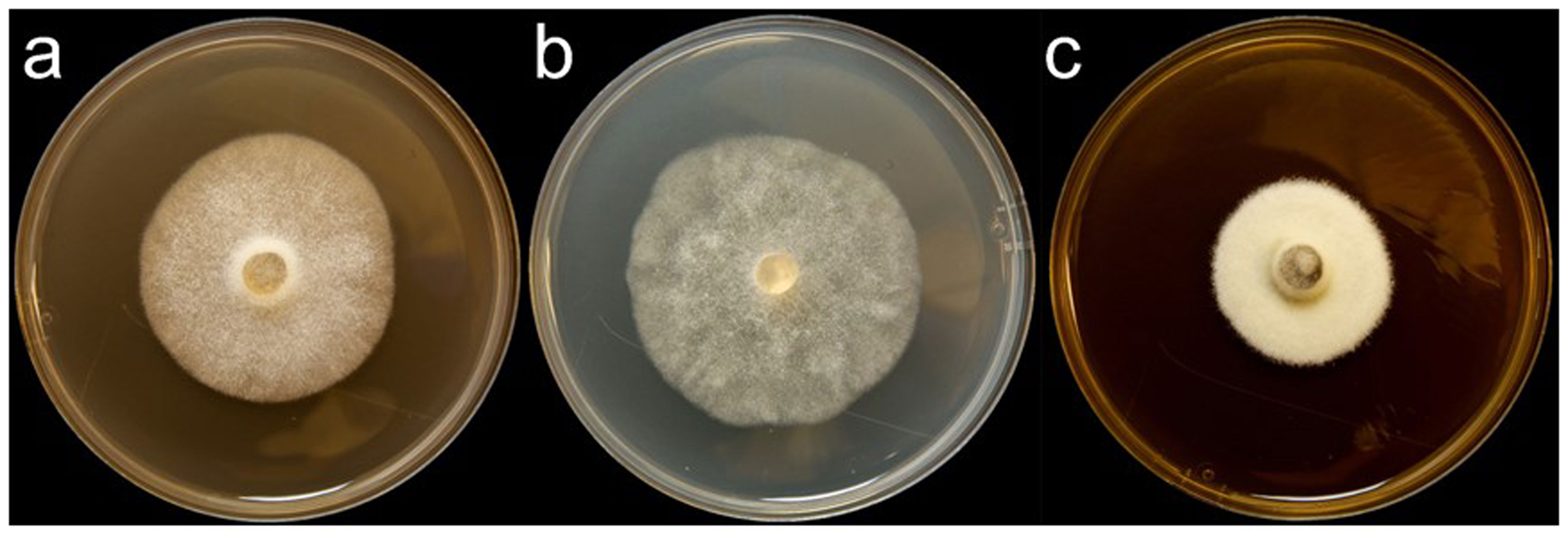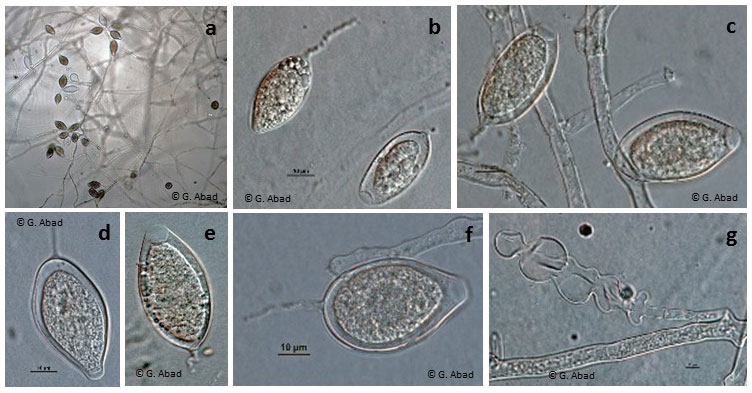Phytophthora colocasiae (in progress - Abad et al. 2023b)
|
Phytophthora spp. in subclade 2a: portion of the seven-loci ML phylogeny featuring the type cultures of 212 described species (by T. Bourret). Notice the position of P. colocasiae selected specimen CBS 149404 = S&T BL 173. Gloria Abad, USDA S&T.
|
|
Phytophthora spp. in subclade 2a: Morphological Tabular key (PDF) and Tabular key legends (PDF) in IDphy2 KEY SECTION. Notice the data of P. colocasiae selected specimen CBS 149404 = S&T BL 173. Gloria Abad, USDA S&T.
|
|
Phytophthora colocasiae colony of selected specimen CPHST BL 35G grown for 7 days on (a) V8 agar, (b) potato dextrose agar, (c) malt extract agar; photos by Krysta Jennings and Leandra Knight, USDA-APHIS-PPQ |
|
Phytophthora colocasiae selected specimen CPHST BL 35G, asexual phase: (a) sporangia in sporangiophores, (b-f) semipapillate sporangia with short and medium length pedicels, (g) hyphal swellings; photos by G. Abad, USDA-APHIS-PPQ |
|
Phytophthora colocasiae selected specimen CPHST BL 35G, sexual phase produced in single culture: (a, b, c) smooth-walled oogonia with amphyginous antheridia and aplerotic oospores; photos by G. Abad, USDA-APHIS-PPQ |
Name and publication
Phytophthora colocasiae Racib. (1900)
Raciborski, M. 1900. Parasitic algae and fungi, Java. Batavia Bulletin of the New York State Museum 19: 189 (pg. 9).
Nomenclature
Mycobank
Typification
from Raciborski (1900)
Type: JAVA, on the leaves of Colocasia esculenta, spread to the whole island, without significant damage to effluent. Is also in the warm level (e.g. in Klaten), as in the present which are best suited for Soekaboemi and Buitenzorfg (in Old West Java which is an island of Indonesia) (taro leaf blight). (LOST)
Well-authenticated specimen selected by Gloria Abad: CPHST BL 173 = P6317 WPC from Colocasia esculenta, INDONESIA (A2)
Selected specimen in other collections
(SE) CBS 149404, NRRL 64370, WPC P6317, S&T BL 173 (Abad)
Molecular identification
Voucher sequences for barcoding genes (ITS rDNA and COI) of the selected specimen (see Molecular protocols page)
Phytophthora colocasiae isolate CPHST BL 173 (= P6317 WPC) = ITS rDNA MG865479, COI MH136875
Voucher sequences for Molecular Toolbox with seven genes (ITS, β-tub, COI, EF1α, HSP90, L10, and YPT1
(see Molecular protocols page) (In Progress)
Voucher sequences for Metabarcoding High-throughput Sequencing (HTS) Technologies [Molecular Operational Taxonomic Unit (MOTU)]
(see Molecular protocols page) (In Progress)
Sequences with multiple genes for selected specimen in other sources
- NCBI: Phytophthora colocasiae CPHST BL 173
- NCBI: Phytophthora colocasiae P6317 (NOTE: ITS rDNA JN618792 P6317 (WPC) does not match the species).
- EPPO-Q-bank: Phytophthora colocasiae
- BOLDSYSTEMS: Phytophthora colocasiae (barcoding COI & ITS)
Position in multigenic phylogeny with 7 genes (ITS, β-tub, COI, EF1α, HSP90, L10, and YPT1)
Clade 2a
Morphological identification
Colonies and cardinal temperatures
Colony colony:
assemblage of hyphae which usually develops form a single source and grows in a coordinated way
morphology after 7 days on V8-A, PDA, MEA with no distinct pattern. Minimum growth temperature 10°C, optimum 22°C, and maximum 30°C.
Asexual phase
SporangiaSporangia:
sac within which zoospores form, especially when water is cooled to about 10°C below ambient temperature; in solid substrates, sporangia usually germinate by germ tubes
semipapillatesemipapillate:
pertaining to the production of shallow having papilla that are not well developed, shallow and less nipple-like than fully papillate structures
; caducouscaducous:
pertaining to sporangia that become dislodged readily (i.e. deciduous) and separate from the sporangiophore (cf. persistent)
with short pedicelpedicel:
the hyphal base of a sporangium that remains attached after the sporangium separates, or is shed, from the sporangiophore; the pedicel may be short (< 5 µm), medium (5–20 µm), or long (> 20 µm)
(3–10 µm length); elongate, ovoidovoid:
egg-shaped, with the widest part at the base of the sporangium and the narrow part at the apex
, or ellipsoidellipsoid:
refers to a solid body that forms an ellipse in the longitudinal plane and a circle in cross section; many fungal spores are ellipsoidal or elliptic
(48–55 µm long x 19–22 µm wide); some sporangiasporangia:
sac within which zoospores form, especially when water is cooled to about 10°C below ambient temperature; in solid substrates, sporangia usually germinate by germ tubes
with tapered basetapered base:
pertaining to the base of a sporangium or oogonium; funnel-shaped
or with lateral attachment; a conspicuous basal plugbasal plug:
a plug protruding into a sporangium from the basal cross wall, separating it from the sporangiophore
is observed in some sporangia; originated in simple or irregularly branched sporangiophores. Hyphal swellings globoseglobose:
having a rounded form resembling that of a sphere
, sub-globose, radiating hyphaehyphae:
single, tubular filament of a fungal or oomycete thallus; the basic structural unit of a fungus or oomycete
, or irregular-shaped are occasionally observed. Chlamydospores globose, terminal or intercalaryintercalary:
positioned within a hypha (cf. terminal)
, observed in some isolates and rare in others (23–31 µm in diam.).
Sexual phase
Heterothallic. Oogonia with smooth wall (20–35 µm diam., av. 29.0 µm); antheridiaantheridia:
the male gametangium; a multinucleate, swollen hyphal tip affixed firmly to the wall of the female gametangium (the oogonium)
amphigynousamphigynous:
pertaining to the sexual stage in which the antheridium completely surrounds the stalk of the oogonium (cf. paragynous)
and subterminal; oosporesoospores:
zygote or thick-walled spore that forms within the oogonium after fertilization by the antheridium; may be long-lived
apleroticaplerotic:
pertaining to a mature oospore that does not fill the oogonium; i.e. there is room left between the oospore wall and oogonium wall (cf. plerotic)
(18–30 µm diam., av. 23.0 µm).
Most typical characters
Phytophthora colocasiae is characterized by the presence of elongate sporangiasporangia:
sac within which zoospores form, especially when water is cooled to about 10°C below ambient temperature; in solid substrates, sporangia usually germinate by germ tubes
with short pedicels.
Specimen(s) evaluated
Phytophthora colocasiae CPHST BL 173, duplicate of isolate P6317 (World Phytophthora Collection)
Hosts and distribution
Distribution: Africa (Ethiopia, East Africa, Fernando Po), Asia, Caribbean (Dominican Republic), North America (USA: CA, NC, HI), Pacific Islands, South America (Brazil, Argentina)
Substrate: leaves, corms, stems
Disease note: leaf blight, corm rot, wilt; also stem canker and black stripe of rubber
Hosts: Colocasia esculenta (taro) and other Aracaceae; also six genera in five other families
Retrieved January 29, 2018 from U.S. National Fungus Collections Nomenclature Database.
Additional references and links
Ann PJ, Kao CW, Ko WH. 1986. Mating-type distribution of Phytophthora colocasiae in Taiwan. Mycopathologia 93: 193-194.
Brooks, F. 2011. Taro leaf blight. APSnet Plant Disease Lessons.
Ko WH. 1979. Mating-type distribution of Phytophthora colocasiae on the island of Hawaii. Mycologia 71: 434-437.
Lin M. and Ko W. 2008. Occurrence of isolates of Phytophthora colocasiae in Taiwan with homothallichomothallic:
pertaining to sexual reproduction that can take place within a single thallus (i.e. self-fertile, non-outcrossing) (cf. heterothallic).
behavior and its significance. Mycologia 100: 727-734.
- SMML USDA-ARS: Phytophthora colocasiae
- EPPO Global Database: Phytophthora colocasiae
- Forest Phytophthoras of the world: Phytophthora colocasiae
- CABI Digital Library: Phytophthora colocasiae
- Encyclopedia of Life (EOL): Phytophthora colocasiae
- Index Fungorum (IF): Phytophthora colocasiae
- Google All Phytophthora colocasiae
- Google Images Phytophthora colocasiae
- Google Scholar Phytophthora colocasiae
Fact sheet author
Z. Gloria Abad, Ph.D., USDA-APHIS-PPQ-S&T Plant Pathogen Confirmatory Diagnostics Laboratory (PPCDL), United States of America.



